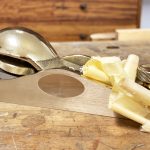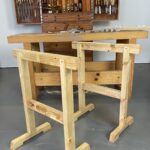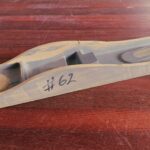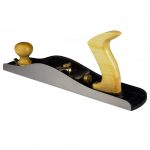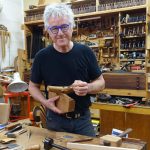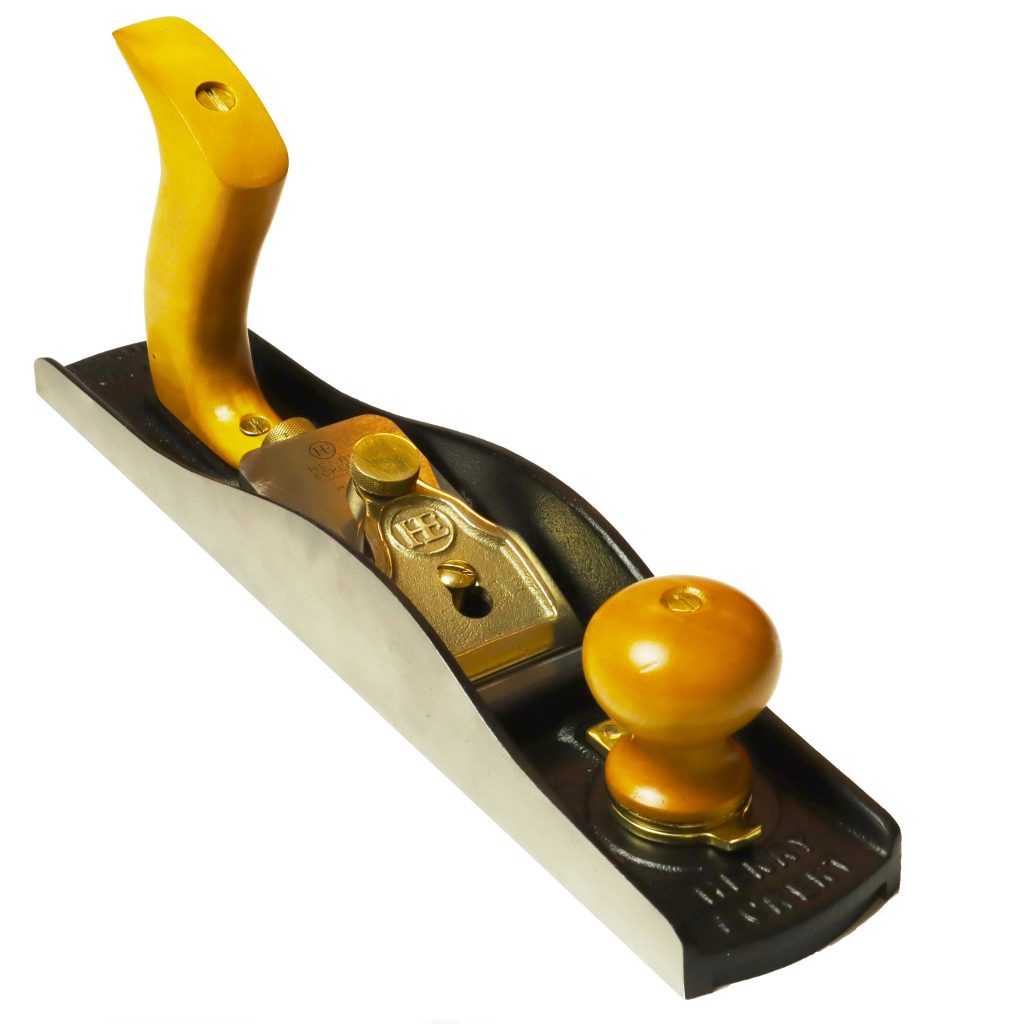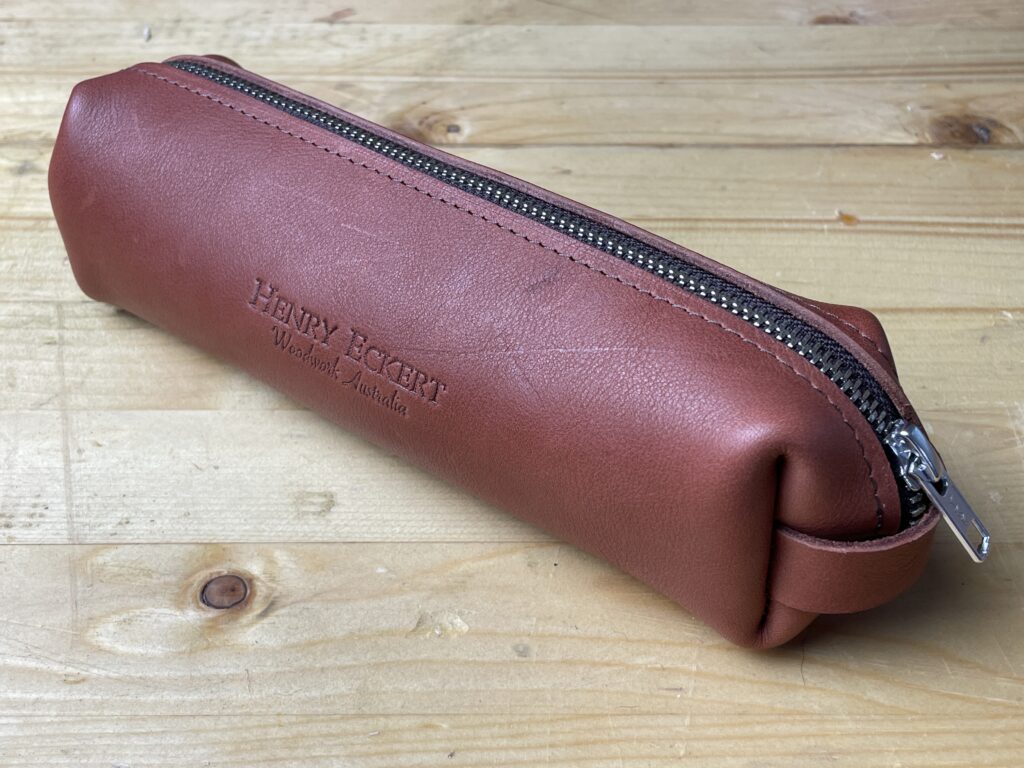Subscribe To Our Newsletter
MANUFACTURERS
MANUFACTURERS
Competing Worldwide
When we first started out attempting to make woodwork tools that hopefully would compete on a world basis we had far more hurdles than we expected. We had many quotes of over $250 to CNC machine a tool, that would mean a retail price of $750 for a low angle jack plane, wouldn’t work or compete. Other machinists just couldn’t do it, too complicated, too much quality required. We determined machinists were in a few categories – rocket scientists, rough & ready, too large, too small, couldn’t reverse engineer, etc. Then we met Jimmy & Mike in Adelaide, South Australia. They were adventurous, talented and practical, perfect for our work. They appreciated our goals, enjoyed perfection, loved competing… They were making aerospace components so they appreciated genuine rocket science… Earlier this year they revealed they were thinking about a robot for their aerospace client. Intriguing to say the least. Well, this week, I saw it in action. Amazing. Their robot loads and unloads two of their 5 axis CNC machines using towers of racks, Astonishing for me, you can spend hours just watching it in action. It doesn’t really replace one of their gifted machinists but enables them to keep machining after hours, no humans. If required, Jimmy & Mike monitor the process on their phones remotely, as the robot works into the early hours of the morning, unattended. It took over two weeks of programming to teach the robot… Out tools are still loaded by hand, but one day, who knows how they will be machined. Fascinating that our tools, that are basically originally designed over 100 years ago, can now be machined with far more precision with a robot today! The tolerances specified by Jimmy & Mike are nothing short of spectacular, giving us the opportunity to compete worldwide. You can see the CNN robot operating on our YouTube channel.
Silent Woodworking
Seems to us at Henry Eckert Hand Tools we are lucky to have the opportunity to work (and play) in a quiet environment while woodworking. Using woodwork hand tools, ‘silent woodworking’ is a far cry from city grind, bad news stories, depressing interest rates, current high cost of living, politicians et al. We enjoy using our hand planes of course but one of the nicest underrated hand tools is the range of hand scrapers we use. Made in France , they have a small price but a large performance, when they’re sharp! Here are some quotes, thoughts and opinions from some of our well known woodworkers. “The hand tool method of woodworking stimulates a level of inventiveness and problem-solving that is unparalleled.” – Chris SchwarzThis quote by Chris Schwarz emphasises the creativity and problem-solving aspect of using hand tools in woodworking, including hand scrapers. We really recommend looking up Chris’ Lost Art Press blog on sharpening hand scrapers, it is simply the best hand scraper sharpening technique, highly recommended. “Hand tools are quiet, portable, and allow you to work with greater precision.” – Roy UnderhillRoy Underhill’s quote emphasises the advantages of using hand tools, including hand scrapers, in woodworking. “I believe that the desire to make beautiful things with our hands connects us to a deeper level of humanity.” – Sam Maloof Sam Maloof was a renowned furniture maker, and this quote encapsulates the profound connection between craftsmanship and the use of hand tools. It suggests that working with hand tools allows woodworkers to tap into their artistic and humanistic nature. “The hand tool is a powerful antidote to the haste and stress of the machine age.” – James Krenov James Krenov, (love this guy) a master cabinetmaker and author, believed in the meditative and therapeutic qualities of working with hand tools. This quote highlights the ability of hand tools to offer a more deliberate and calming approach to woodworking, allowing woodworkers to escape the fast-paced world around them. “In a machine age, handmade is the ultimate luxury.” – Garrett Hack Garrett Hack, a renowned furniture maker and author, ( and visitor to Adelaide) emphasises the value of handmade craftsmanship in a world dominated by machines. This quote underscores the uniqueness and artistry that hand tools bring to woodworking, making it a coveted and exceptional endeavor. “The hand tool shapes, joins, and finishes the material, but it also shapes, joins, and finishes the maker.” – Toshio Odate Toshio Odate, a Japanese woodworking master, highlights the profound relationship between the woodworker and hand tools. This quote suggests that the use of hand tools not only shapes the wood but also has a transformative effect on the woodworker, honing their skills and character. Paul Sellers is a renowned woodworker and instructor known for his focus on traditional hand tool techniques. He has frequently talked about the use of hand scrapers in achieving a fine finish on wood surfaces. He emphasizes the importance of sharpening and using hand scrapers properly to achieve excellent results. While not primarily a woodworker, Bob Flexner is a well-known authority on wood finishing. In his book “Understanding Wood Finishing,” he discusses the role of hand scrapers in preparing wood surfaces for finishing. He provides insights into sharpening techniques and their benefits compared to sanding. We reckon these quotes capture the essence of the value and significance that renowned woodworkers place on using hand tools in their craft. Hand tools not only enable precision and control but also foster a deeper connection to the materials and the woodworking process itself.
No 62 Low Angle Jack – Worth the Weight
I know many woodworkers may claim their small block plane or their adjustable mouth block plane is the most used plane in their shop but when it comes to bench planes it would have to be the No 62 Low Angle Jack or a No 5 bench plane. Both flatten, straighten, smooth, take thick aggressive shavings, just about everything when compared to a shorter smoothing plane or the longer jointer which are far more specialised. When we first sampled our No 62 the main initial concept was our plan to increase the weight marginally in the sole which also lowers the centre of gravity. Why? Well, many years ago we had access to a range of Lie-Nielsen bench planes. The go to jack plane was the No 62, but, on occasion we used the No 5 which somehow seemed to plane with more authority, and track better. It just seemed to plane ‘better’. This was not about bevel up / bevel down comparison, we determined it was about the weight and the positioning of the weight. The LN No 62 weighed 2.1 kgs, the LN No 5 was 2.5 kgs. Of course, a No 5 has a heavier frog & a chipbreaker. We re-cast, machined, experimented, and finally decided the Henry Eckert No 62 performed best weighing in at 2.37 kgs. Again, many years ago, woodworkers (or pseudo woodworkers) at wood shows would often pick up any LN plane and say ‘it is heavy’. We guessed their experience was with old Stanley type planes which were much lighter, for example, an old No 5 Stanley weighs in at 1.98 kgs. Or, maybe no experience with hand planes. But, bench planes are not used in mid-air, they sit on wood to perform their magic, so why judge them bouncing them around from hand to hand? We found the lower centre of gravity, and mass, improved stability. The plane seemed less likely to chatter or skip on the surface of the wood, resulting in a more consistent finish. It seemed to us the blade was more ‘engaged’ with the workpiece, if this is possible? but, it was what it felt like… We also found the extra mass helped to maintain momentum, making it easier to push the plane through tougher sections of wood, especially when dealing with tear-out or harder woods. So the most versatile bench plane, the No 62, due to its dimensions and not least, the variety of use changing blades in the tool gives, is today our go to plane…
PM-10V versus A2 & O1 tool steel…
Powdered metallurgy tool steel PM-10V, A2 tool steel, and O1 tool steel are all high-performance materials used for making cutting tools. Here is a short comparison of their properties: Overall, PM-10V is the superior material for high-performance cutting tools that require superior wear resistance and edge retention, but it is also the most expensive! A2 and O1 tool steels are still excellent choices for many cutting tool applications, depending on the specific requirements and budget. All three materials can be optimized through proper heat treatment and processing to achieve desired properties. Many woodwork hand tool tool manufacturers use A2 tool steel because it is very good. Our initial strategy was simply to use the best tool steel we could get supplied. PM-10V fitted that bill but perhaps we could maintain tool prices if we offered A2 as well?
A short history of metal, wood, food safe & thread wax…
Metal WaxIn the Middle Ages, beeswax became a popular choice for protecting metal objects, particularly those used for liturgical purposes. Beeswax was often mixed with other ingredients, such as resin or turpentine, to create a more durable coating. Waxes have been used for centuries as a way to protect and enhance the appearance of metal objects. In ancient times, waxes made from animal fat and oils were used to seal and protect metal objects from rust and corrosion.During the Renaissance, new methods of wax preparation were developed, including the addition of pigments to create colored waxes. These colored waxes were used to highlight and accentuate the details of metalwork.In the 18th century, a French chemist named Michel-Eugène Chevreul developed a method for making synthetic waxes using fatty acids and alkalis. This allowed for the creation of waxes that were more stable and had a longer shelf life than natural waxes.HE Metal Wax is a special blend of Paraffin Wax, Carnauba Wax and Linseed Oil. All ingredients are pure and safe. Wipe on your hand saws, table saws, planer tables & thicknessers with a soft cloth or 0000 steel wool. Wipe off excess and allow to dry. We now produce this wax in a ‘soft finish’ for much easier application. The Metal Wax will lubricate your hand saws and minimise friction when sawing. It will also allow timber to move over your table saws, planers, thicknessers etc. much more freely without catching.The Metal Wax also helps prevent rust & tarnish by locking out oxygen & moisture. Wood WaxWaxes have been used for centuries as a way to protect and enhance the appearance of wood. In ancient times, people used natural waxes, such as beeswax, to protect wooden objects and furniture from damage and deterioration. During the Middle Ages, beeswax continued to be a popular choice for protecting and preserving wood. It was often mixed with other natural ingredients, such as turpentine or linseed oil, to create a more durable coating.In the 18th century, a French furniture maker named André Jacob Roubo developed a method for making a special wax finish for furniture. The finish, known as “French polish,” was made by dissolving shellac flakes in denatured alcohol and then applying the mixture to wood in thin layers using a pad.In the 19th century, new types of waxes were developed for wood, including carnauba wax, which is derived from a Brazilian palm tree. Carnauba wax is particularly popular for use on floors and furniture, as it creates a hard, glossy surface that is resistant to water and scratches.HE Wood Wax is a special blend of Beeswax, Carnauba Wax, Citrus Oil and Linseed Oil. We now produce it in a ‘soft finish’ for much easier application. All ingredients are pure and safe. We highly recommend either a sharp smoothing plane mirror finish or a 400 grit sandpaper finish on your piece before applying the wax.Wipe on new or old wood with a soft cloth or 0000 steel wool. Allow around 15 to 30 minutes, depending on ambient temperature, and then buff to a luxurious lustre by hand or buffing machine. Do not leave any smears as they will harden over time, buff them off. Food Safe WaxFood safe wood wax is a relatively recent development in the history of waxes for wood. The demand for food safe wood finishes grew as people became more aware of the potential health risks associated with traditional wood finishes, which can contain harmful chemicals and heavy metals. In the late 20th century, a number of companies began developing natural waxes and oils that were safe for use on food contact surfaces, such as cutting boards, wooden utensils, and countertops. These food safe wood waxes and oils are typically made from natural ingredients, such as beeswax, carnauba wax, and plant-based oils like linseed oil, walnut oil, or tung oil.One of the earliest food safe wood waxes to gain popularity was mineral oil, a colorless and odorless liquid derived from petroleum. Mineral oil is widely used as a lubricant and laxative, and has been approved by the US Food and Drug Administration (FDA) for use in food contact applications.In recent years, there has been a growing interest in natural and organic food safe wood waxes, which do not contain petroleum-derived ingredients. These waxes are often made from plant-based oils and waxes, such as beeswax, carnauba wax, or soy wax, and may be blended with other natural ingredients, such as citrus oils, to enhance their properties.HE Food Safe Wax is a special blend of Beeswax, Carnauba Wax, Citrus Oil and Olive Oil (and Vitamin E for longevity). All ingredients are pure and safe. We highly recommend either a sharp smoothing plane mirror finish or a 400 grit sandpaper finish on your piece before applying the wax.Wipe on new or old wood wooden bowls, cutting boards, spoons, salad servers with a soft cloth or 0000 steel wool. Allow around 15 to 30 minutes, depending on ambient temperature, and then buff to a luxurious lustre by hand or buffing machine. Do not leave any smears as they will harden over time, buff them off. Thread WaxScrew wax, also known as thread lubricant or screw lube, is a type of wax or grease that is applied to screws to reduce friction and make them easier to turn. The use of screw wax dates back to the early 20th century, when it was first developed as a way to improve the performance of machine screws and other types of fasteners. One of the earliest and most popular types of screw wax was a product called “Loctite,” which was developed in the 1950s by the American company American Sealants Inc. Loctite was a thick, white paste that was applied directly to screw threads before they were inserted into a hole. Once the screw was tightened, the Loctite would harden and provide a secure, long-lasting seal. In the 1960s and 1970s, other types of screw wax and lubricants were developed, including silicone-based lubricants, Teflon-based lubricants, and…
Marking gauges, markers, pencils, & their storage
A marking gauge is used in woodworking to make precise and accurate measurements and markings on wood. It consists of a beam, a marking wheel or cutter, and a locking mechanism to hold the setting in place. Marking gauge use… Markers, on the other hand, are used to make visible markings on wood, such as lines or shapes, that can be followed during the cutting or shaping process. Marker use.. By using marking gauges and markers in woodworking, you can achieve precise and accurate measurements and markings. Is a 2B pencil lead the best for notes and marking wood A 2B pencil lead is a popular choice for note-taking and sketching because it is soft enough to provide a darker line, but not so soft that it smudges easily. A 2B pencil also marks timber well, particularly if the pencil follows a previously marked line. Wood is a porous and fibrous material, and pencil lead can be easily absorbed and trapped within the grain of the wood, making it difficult to see or erase, if used on its own. A marking knife, on the other hand, is a specialized tool that is used to score or cut a precise line into the surface of the wood. This can be particularly useful for marking out joinery or other intricate details that require a high degree of accuracy. What is the best way to store woodworking pencils, leads, marking knife and compasses? Proper storage of woodworking pencils, leads, marking knives, and compasses is important to ensure that they remain in good condition and are easily accessible when needed. Here are some tips on how to store these tools: By following these tips, you can help ensure that your woodworking pencils, leads, marking knives, and compasses remain in good condition and are easily accessible when you need them.
Why are forged high carbon steel chisels more comfortable…
Good quality woodwork chisels are normally judged on their ability to start sharp longer, why not, less sharpening time is a benefit for sure. But, what about use, are milled tool steel chisels in, say, A2, M2 or PM nice to use. Sure they are high on abrasive qualities (stay sharper longer), tough and hard. Yes hard, 63+ HRC. Hardness means stiffness, they can transmit vibrations into hands & arms, they do not have much ‘give’. So, can a chisel be more comfortable than another, well yes it can. The age old method of hand forging high carbon steel produces a chisel that is softer (55 HRC) than milled tool steel but still certainly hard enough to carve, cut, shave all types of wood with a fine grain steel super sharp edge. And, it is comfortable to use, better feel, better feedback, and so easy to resharpen… An interesting and often ignored concept, chisel comfort. Here is a simplified explanation of the forged chisel making process… They are made using a traditional metalworking process that involves heating, shaping, and tempering the metal to create a strong, durable tool. Here are the general steps involved in making a forged woodwork chisel: Overall, forging a woodwork chisel is a time-intensive process that requires a high degree of skill and expertise, but quality never goes out of style. A good reference book for appreciating forged tools & blades is Ron Hock’s book, “The Perfect Edge”
No 62 Low Angle Jack Plane five years on…
Our patternmaker at the time, David Weston, made our first plane pattern in 2018, the No 62 based on the early century Stanley plane. The pattern was shaped out of wood and was accompanied by patterns for the adjustable mouth shoe & the bronze cap iron, it was a big day! The bronze cap iron was designed by Melbourne designer & woodworker, Tim McQuiston. Of course the design of our first plane had to be determined prior to pattern making. We had some criteria that we wanted to achieve. Prior to Henry Eckert Hand Tools we imported tools from Lie-Nielsen which included a wide range of demo tools that we used regularly. My go to tool was nearly always the No 62, I liked the simplicity and the flexibility. Occasionally I would pick up a No 5 bench plane and it always felt different in the planing action, better I thought. It wasn’t due to bevel down / bevel up difference, or the height, it was the weight, the heft. The No 5 seemed to stay on track more, more grounded, more powerful. It was an intriguing discovery. Our first design change was to add more weight to the sole of the plane, lower the centre of gravity, to get the advantage we had enjoyed with the No 5. We looked at lateral adjustment of the blade but decided we would keep the plane simple, a snug fit for the blade with some lateral adjustment room. A Norris adjuster would give lateral movement but the design of a low angle plane blade height from the base and the positioning of the handle would have required a very short Norris adjuster which would be far too sensitive due to the lever physics when lateral adjustment was attempted. All planes rely on the blade to perform, it is the most important and most neglected part of the tool. Any planing ‘problems’ nearly always come back to the blade. We decided to find and use the best tool steel we could, which was PM- 10V tool steel. Powdered metallurgy technology gives easy sharpening and long term sharpness along with durability. Keeping the blade straight when adjusting was achieved by Queensland woodwork teacher & artisan, Bob Howard. Bob invented the Howard Adjuster which included a bearing to stop the adjuster catching on the blade causing lateral movement and removed the friction component making silky smooth adjustments. We also wanted to use native Australian timbers for the handles. Australia’s most popular tree, the River Redgum, was our choice in fiddleback form along with the legendary Tasmanian timber Huon Pine. The casting in virtually unbreakable Ductile Iron and the machining was our next hurdle. The casting quality was reasonably quickly achieved but the the machining was a journey. After many attempts we finally achieved our goals of flatness, 90° sides, accuracy, stability and aesthetics. The performance of the plane was what we wanted to exploit. We were aware of the flexility a Low Angle Bevel Up plane provided. A range of blades including higher micro bevels, 90° scraper blades and a toothed blade exploited the flexibility of this tool. Unfortunately, at the time of writing, pandemic tool steel issues have made us reduce our plane blade range but they will be back. Using a low angle plane on a shooting board is wise. The blade cutting angle planes end grain well which is often found in the shooting board environment. We made our own hot dog handle to make the shooting process more comfortable. Whilst we are talking about low angle planes without a chipbreaker that a bevel down bench planes brings, we are not anti-chipbreaker. The Low Angle Jack allows the woodworker to conquer tear out timber with a quick change to a higher angled plane blade. This can be achieved with a bevel down bench plane but the set up is not always correct, and sometimes hard to achieve with some tools. This feature of changing blades rather than changing tools for tear out, scraping, hogging out rough timber, smoothing, end grain planing etc is the Low Angle jack Plane’s major advantage. I guess, if you could only have one woodwork hand plane this would be the one! See them here…
Starting with Woodwork Hand Tools – Chisels
Chisels are absolutely necessary for woodwork. They are effective, efficient and enjoyable to use. Due to their practical results there are many types of chisels. We will cover the three most popular types here as well as discuss quality, edge angles & tool steel. Bench chisels Western Bench Chisels can have flat edges or bevel edges. Bevel edges are good for getting into corners like you find in dovetails. They are a far better universal use than flat sided bench chisels. Of course there are many sizes, but three sizes is a good place to start. Suggest 6mm(1/4″), 12mm(1/2″) & 19mm(3/4″).Japanese bench chisels usually have bevel edges. They are often thicker than western bench chisels. We recommend you seek out thinner, (or not bulky), bench chisels, better for tight spots and still not lacking in strength. Mortise Chisels Mortise chisels are a special purpose chisel. They are much thicker than all other chisels we generally use. They need this lateral strength for levering timber out of a mortise slot. Tenon & mortise joints are certainly worth mastering. You will use a mortise chisel for taking out layers of wood in the mortise and often a bench chisel for straightening and cleaning up the sides and ends of the mortise slot.Sizes similar to bench chisels. A mortise gauge can use the chisel width for setting the width of a mortise marking out. Paring Chisels We love paring chisels. They are long, thin and elegant. They are used to flatten or straighten a slot, edge or rebate and many other types of joints. They are the chisel version of a long jointing plane. Long & flat sliding across the workpiece! Can be considered a finishing clean up chisel…Sizes would be similar to bench chisels above, but you may only need one or two smaller sizes to start off. Tool Steel & Edge Angles This is probably the most important part of chisel choice. Modern tool steels, O1, A2, PM -10V have greatly improved chisel performance. Simply put, they are strong and hence reduce chipping as well as having good abrasive qualities which allows them to stay sharper longer. There have been many chisel tool steels over the years, high speed carbon etc. Some are good, some are not, bit of a lottery. Japanese chisels often have very good steel, laminated as well as blue & white paper steel. These are usually very good, price seems to dictate quality. There are lots of comments and opinions regarding the angle of the chisel cutting edge. Chisel edges do get some tough work during woodwork sometimes, as a general rule we would recommend a micro or secondary bevel of 35°. This angle cuts very well but importantly has a little more ‘meat’ to give the edge more strength. A paring chisel can be a finer angle of 25° or 30° due to its type of work.


